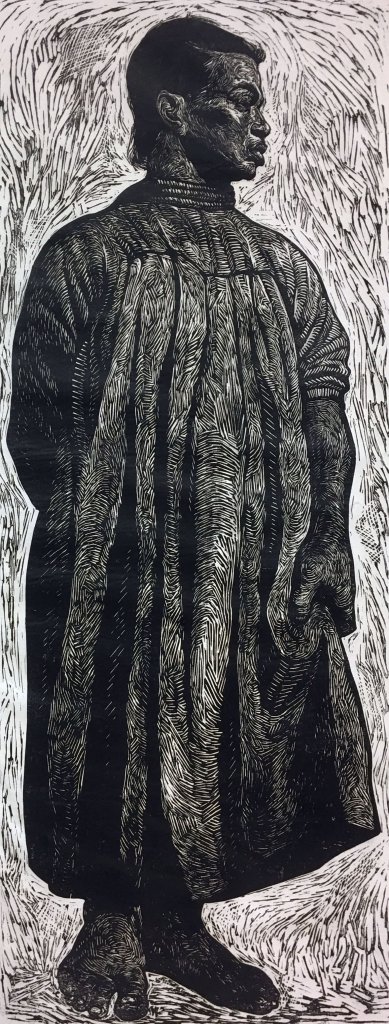Cover Art Commentary: Gregg Hertzlieb on Charles White

Charles White (1918-1979)
Solid as a Rock (My God is Rock), 1963
Linocut on paper, 38 1/4 x 14 3/4 inches
Violet Berge Fund Purchase
Brauer Museum of Art, 2018.24
A major new addition to the Brauer Museum of Art’s permanent collection is a linocut by the legendary African American artist Charles White. White was the subject of a traveling retrospective exhibition that was on display at the Art Institute of Chicago from June 8 to September 3, 2018. For many viewers, the retrospective exhibition was their first exposure to this remarkably talented artist; White enjoyed some measure of fame during his lifetime, although only now does White seem to be getting the respect he deserves for his inventive compositions and virtuoso draftsmanship. Throughout his career, White chronicled the struggles and experiences of African Americans in their lives.
One of the featured pieces in the retrospective exhibition was the linocut Solid as a Rock (My God is Rock). Printed by the artist from his linoleum block, the piece demonstrates the artist’s technical skill in evenly printing from the large and detailed matrix. White carved the block in 1958 and then made prints from it as needed, signing and dating each one. The Art Institute and the Museum of Modern Art in New York City each have impressions of this image. To acquire this piece for the collection, the Brauer Museum worked with Heritage Gallery in California, White’s longtime dealer and a lender to and organizer of the White retrospective.
The explanatory label that accompanied the piece in the Art Institute exhibition provided helpful information about the possible source of the enigmatic title. It explained, “White’s art was frequently inspired by the intersections of spirituality and music, and this work was likely inspired by Paul Robeson’s vinyl LP Solid Rock: Favorite Hymns of My People (1955). The title hymn includes the lyric, ‘On Christ the solid rock I stand / All other ground is sinking sand.'” The exhibition included several representations of Robeson himself that White did over the years. The central subject of the picture has a solid or massive appearance, with bodily details hidden under the full length shirt or robe. The most striking detail of the figure is the bare feet that in their size seem to anchor the subject to the ground. Nothing separates the figure’s feet from the ground, establishing the subject as stable, connected to the sacred earth or perhaps the floor of a worship space. The subject of the linocut casts a sideward gaze, ready to serve a God who prizes steadfast determination, confidence, and strength in the execution of divine directive. White’s creation is a being of too solid flesh, simultaneously the personification or manifestation of faith. The figure’s attitude is matter of fact, radiating power outwardly and drawing power from within.
Through wonderfully skillful manipulation of the positive/negative nature of carving a design into a linoleum block, White is able to present realistically the folds of a garment, the bold contours of the subject (distinguished in the density of marks from the lively background), and the facial characteristics that impart to viewers a nobility in demeanor. Relief printmaking gives artists the capabilities to print multiple impressions, but the black/white nature of the medium means that artists must adapt their visions to work with an art form that poses immediate technical limitations. In addition to drawing beautifully—the retrospective exhibition was comprised largely of drawings—White was able to coax such subtlety out of a recalcitrant block. His artistic voice, his talent, was such that it drove his hand to overcome obstacles presented by new media and therefore create art in any format he attempted.
This piece comes from a fund established for acquisitions by Violet Berge. Violet and her late husband Robert have enhanced the Brauer Museum’s permanent collection with many works of art by Joan Miro and Rufino Tamayo. Recently, Violet gave the Brauer Museum a lovely gift of funds to be used for acquisitions. After founding director Richard Brauer, museum donor Josephine Ferguson, and I saw the Charles White exhibition at the Art Institute, we knew that the artist deserved a place in the collection. I remember the three of us standing before Solid as a Rock in the exhibition and saying, “This would be a fine work to have for our museum and university. It’s an image of faith, of confidence, of stability in going forward and serving, helping, with inner and outer strength.” Perhaps such a sentiment was something of an incantation, because thanks to Violet Berge’s generosity we now have this incredible work of art that we can share with the campus and community.
Gregg Hertzlieb is Curator and Director of the Brauer Museum of Art at Valparaiso University. Hertzlieb is the editor of the books The Calumet Region: An American Place (Photographs by Gary Cialdella), published in 2009, and Domestic Vision: Twenty-Five Years of the Art of Joel Sheesley (2008), as well as a contributor to The Indiana Dunes Revealed: The Art of Frank V. Dudley (2006). He has been awarded the Edward L. Ryerson Traveling Fellowship by the School of the Art Institute in Chicago and a Conant Writing Award for Poetry from Millikin University. His artwork has been exhibited widely, including at the Aron Packer Gallery, August House Studio, the Central School of Art and Design in London, Columbia College, Elgin Community College, the Goodman Theater, Struve Gallery, and the Ellen Firme Gallery.